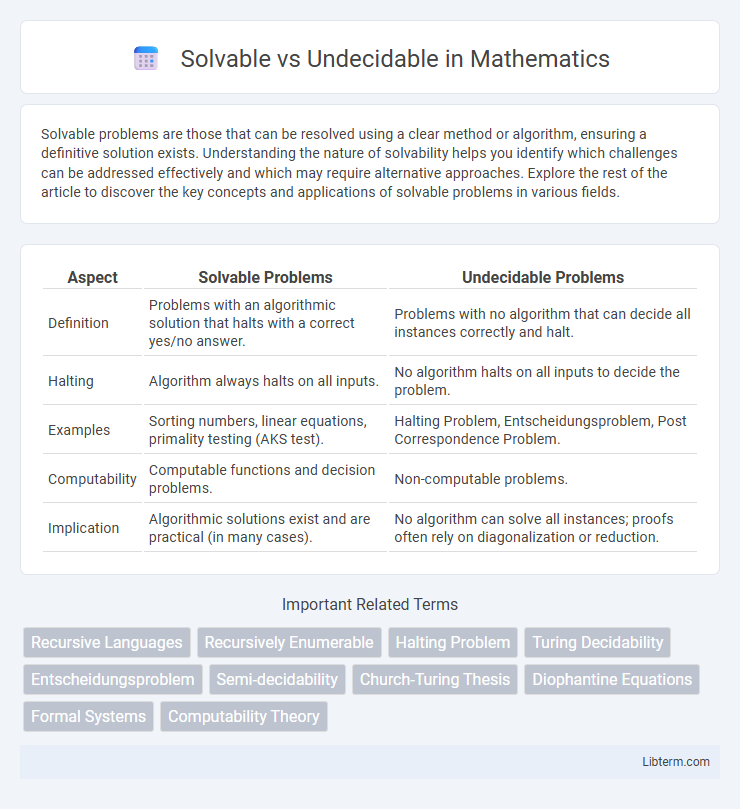Solvable problems are those that can be resolved using a clear method or algorithm, ensuring a definitive solution exists. Understanding the nature of solvability helps you identify which challenges can be addressed effectively and which may require alternative approaches. Explore the rest of the article to discover the key concepts and applications of solvable problems in various fields.
Table of Comparison
| Aspect | Solvable Problems | Undecidable Problems |
|---|---|---|
| Definition | Problems with an algorithmic solution that halts with a correct yes/no answer. | Problems with no algorithm that can decide all instances correctly and halt. |
| Halting | Algorithm always halts on all inputs. | No algorithm halts on all inputs to decide the problem. |
| Examples | Sorting numbers, linear equations, primality testing (AKS test). | Halting Problem, Entscheidungsproblem, Post Correspondence Problem. |
| Computability | Computable functions and decision problems. | Non-computable problems. |
| Implication | Algorithmic solutions exist and are practical (in many cases). | No algorithm can solve all instances; proofs often rely on diagonalization or reduction. |
Introduction to Solvable and Undecidable Problems
Solvable problems are computational tasks for which an algorithm can provide a solution in finite time, exemplified by problems like sorting or finding the greatest common divisor. Undecidable problems lack any algorithmic method to guarantee a solution for all possible inputs, with the Halting Problem being a classic example. Understanding the distinction between solvable and undecidable problems is fundamental in theoretical computer science and computability theory.
Defining Solvable Problems in Computation
Solvable problems in computation refer to those for which an algorithm exists that can provide a correct yes-or-no answer for every input within finite time. Such problems are characterized by their decidability, meaning they can be resolved through systematic procedures or Turing machines. Identifying solvable problems involves demonstrating a clear decision process, contrasting them with undecidable problems where no algorithm can guarantee termination with an accurate result for all inputs.
What Makes a Problem Undecidable?
A problem is undecidable when no algorithm can determine the answer for all possible inputs within finite time, often due to its inherent computational complexity or the infinite nature of its input space. Undecidability arises from problems that require solving the Halting Problem or involve self-referential structures, making it impossible to construct a general decision procedure. Key examples include the Halting Problem, the Post Correspondence Problem, and certain decision problems in formal languages and logic, which highlight fundamental limits of computation.
Key Examples of Solvable Problems
The Halting Problem exemplifies an undecidable problem, where no algorithm can determine whether arbitrary programs halt or run indefinitely. In contrast, sorting algorithms like QuickSort and MergeSort are key examples of solvable problems, efficiently arranging data in polynomial time. Other solvable problems include shortest path computations in graphs using Dijkstra's algorithm and linear programming problems solved optimally by the Simplex method.
Famous Undecidable Problems in Computer Science
Famous undecidable problems in computer science include the Halting Problem, which asks whether a given program will finish running or continue indefinitely, and Rice's Theorem, which states that all non-trivial semantic properties of programs are undecidable. Other notable examples are the Post Correspondence Problem and the Entscheidungsproblem posed by David Hilbert, both demonstrating fundamental limits in algorithmic computation. These problems highlight the inherent boundaries of decidability, shaping the theory of computation and complexity classes.
Theoretical Foundations: Turing Machines and Computability
Turing machines provide the theoretical foundation for distinguishing solvable problems, which can be decided by an algorithm, from undecidable problems that no algorithm can resolve in all cases. Computability theory explores the limits of what Turing machines can achieve, identifying problems like the Halting Problem as inherently undecidable. This framework establishes critical boundaries in computer science between algorithmically solvable tasks and those beyond mechanical computation.
Practical Implications of Undecidability
Undecidability in computational theory indicates problems for which no algorithm can determine a solution in all cases, impacting software verification, formal methods, and security analysis. Practical implications include the inability to guarantee termination or correctness of certain programs, forcing reliance on heuristic or approximate methods. Understanding the boundaries between solvable and undecidable problems guides developers in designing algorithms and systems that avoid computational intractability and ensure reliability.
Decision Procedures for Solvable Problems
Decision procedures for solvable problems provide algorithmic methods that always terminate with a correct yes-or-no answer regarding the problem's membership or validity. These procedures rely on well-defined logical frameworks and decidable theories, such as Presburger arithmetic or context-free languages, ensuring that every instance can be conclusively resolved. Efficient decision procedures facilitate automated reasoning, formal verification, and algorithmic problem solving within computable boundaries.
Limits of Computation: Exploring the Church-Turing Thesis
The Church-Turing thesis establishes the foundation for identifying solvable problems as those that algorithms or Turing machines can compute within finite steps, while undecidable problems lack any effective computational method for solution. This demarcation emphasizes the inherent limits of computation, showing that certain decision problems, such as the Halting Problem, cannot be resolved by any algorithm. Understanding these boundaries guides theoretical computer science in exploring the capabilities and restrictions of algorithmic processes.
Real-World Impact: Why Understanding Solvable vs Undecidable Matters
Understanding the distinction between solvable and undecidable problems is crucial for optimizing computational resources and setting realistic expectations in fields like cryptography, artificial intelligence, and software verification. Solvable problems have algorithms guaranteeing solutions, enabling reliable automation and decision-making, while undecidable problems highlight fundamental limits, guiding researchers to avoid futile solution attempts. Recognizing these boundaries drives innovation by focusing effort on feasible challenges and leveraging approximate or heuristic methods for otherwise intractable tasks.
Solvable Infographic

 libterm.com
libterm.com